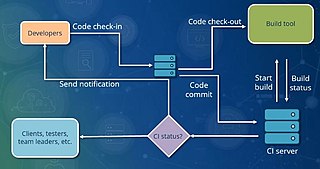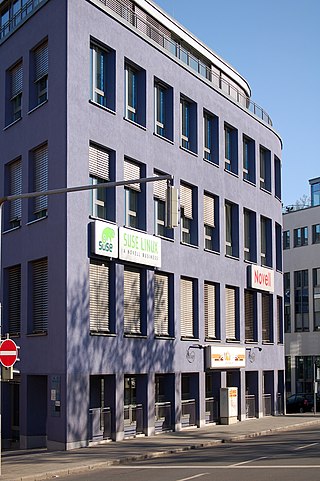
WordStar is a word processor application for microcomputers. It was published by MicroPro International and originally written for the CP/M-80 operating system, with later editions added for MS-DOS and other 16-bit PC OSes. Rob Barnaby was the sole author of the early versions of the program.
Concurrent Versions System is a revision control system originally developed by Dick Grune in July 1986.
In software engineering, version control is a class of systems responsible for managing changes to computer programs, documents, large web sites, or other collections of information. Version control is a component of software configuration management.

Apache Subversion is a software versioning and revision control system distributed as open source under the Apache License. Software developers use Subversion to maintain current and historical versions of files such as source code, web pages, and documentation. Its goal is to be a mostly compatible successor to the widely used Concurrent Versions System (CVS).
In computer science, software transactional memory (STM) is a concurrency control mechanism analogous to database transactions for controlling access to shared memory in concurrent computing. It is an alternative to lock-based synchronization. STM is a strategy implemented in software, rather than as a hardware component. A transaction in this context occurs when a piece of code executes a series of reads and writes to shared memory. These reads and writes logically occur at a single instant in time; intermediate states are not visible to other (successful) transactions. The idea of providing hardware support for transactions originated in a 1986 paper by Tom Knight. The idea was popularized by Maurice Herlihy and J. Eliot B. Moss. In 1995 Nir Shavit and Dan Touitou extended this idea to software-only transactional memory (STM). Since 2005, STM has been the focus of intense research and support for practical implementations is growing.

Multiuser DOS is a real-time multi-user multi-tasking operating system for IBM PC-compatible microcomputers.

In software engineering, continuous integration (CI) is the practice of merging all developers' working copies to a shared mainline several times a day. Nowadays it is typically implemented in such a way that it triggers an automated build with testing. Grady Booch first proposed the term CI in his 1991 method, although he did not advocate integrating several times a day. Extreme programming (XP) adopted the concept of CI and did advocate integrating more than once per day – perhaps as many as tens of times per day.

SUSE is a German-based multinational open-source software company that develops and sells Linux products to business customers. Founded in 1992, it was the first company to market Linux for enterprise. It is the developer of SUSE Linux Enterprise and the primary sponsor of the community-supported openSUSE Linux distribution project. While the openSUSE "Tumbleweed" variation is an upstream distribution for both the "Leap" variation and SUSE Linux Enterprise distribution, its branded "Leap" variation is part of a direct upgrade path to the enterprise version, which effectively makes openSUSE Leap a non-commercial version of its enterprise product.
In software development, version control is a class of systems responsible for managing changes to computer programs or other collections of information such that revisions have a logical and consistent organization. The following tables include general and technical information on notable version control and software configuration management (SCM) software. For SCM software not suitable for source code, see Comparison of open-source configuration management software.
Configuration Management Version Control (CMVC) is a software package that serves as an object repository, and performs software version control, configuration management, and change management functions.
SUSE Linux is a computer operating system developed by SUSE. It is built on top of the free and open source Linux kernel and is distributed with system and application software from other open source projects. SUSE Linux is of German origin, its name being an acronym of "Software und System-Entwicklung", and it was mainly developed in Europe. The first version appeared in early 1994, making SUSE one of the oldest existing commercial distributions. It is known for its YaST configuration tool.
Polytron Corp. was a software company founded in 1982 to create a line of instrumentation products for the IBM Personal Computer. It was the creator of the Polytron Version Control System (PVCS). The company was acquired by Sage Software of Rockville, Maryland in 1989, and is now part of Serena Software.
Micro Focus International plc was a British multinational software and information technology business based in Newbury, Berkshire, England. The firm provided software and consultancy. The company was listed on the London Stock Exchange and the New York Stock Exchange until it was acquired by the Canadian software firm OpenText in January 2023.
With operations in 11 countries, Serena Software Inc. is an American software company that provides IT management products to enterprises. Serena solutions offer a process orchestration approach and span the areas of development, DevOps and IT management.
Data Protector software is automated backup and recovery software for single-server to enterprise environments, supporting disk storage or tape storage targets. It provides cross-platform, online backup of data for Microsoft Windows, Unix, and Linux operating systems. The last version to use the OmniBack name was version 4.1, which was retired in 2004.

GroupWise is a messaging and collaboration platform from Micro Focus that supports email, calendaring, personal information management, instant messaging, and document management. The GroupWise platform consists of desktop client software, which is available for Windows,, and the server software, which is supported on Windows Server and Linux.
Perforce Software, Inc. is an American developer of software used for developing and running applications, including version control software, web-based repository management, developer collaboration, application lifecycle management, web application servers, debugging tools and agile planning software.
Dimensions CM is a software change and configuration management product developed by Micro Focus. It includes revision control, change, build and release management capabilities.





